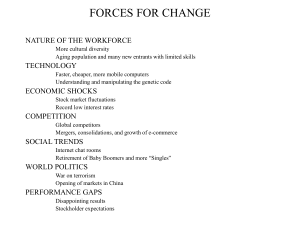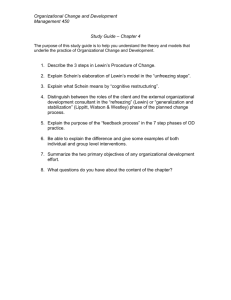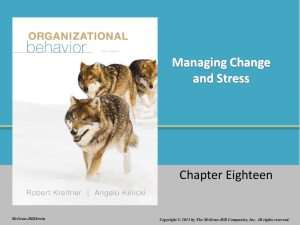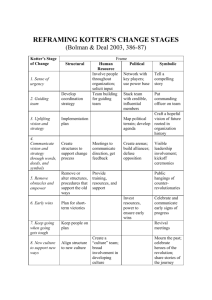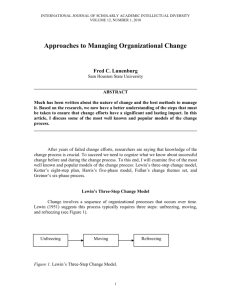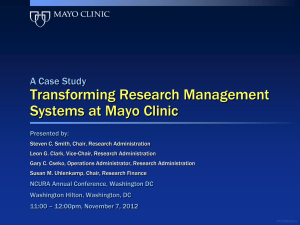Group 7-Write up shared by Divya
advertisement
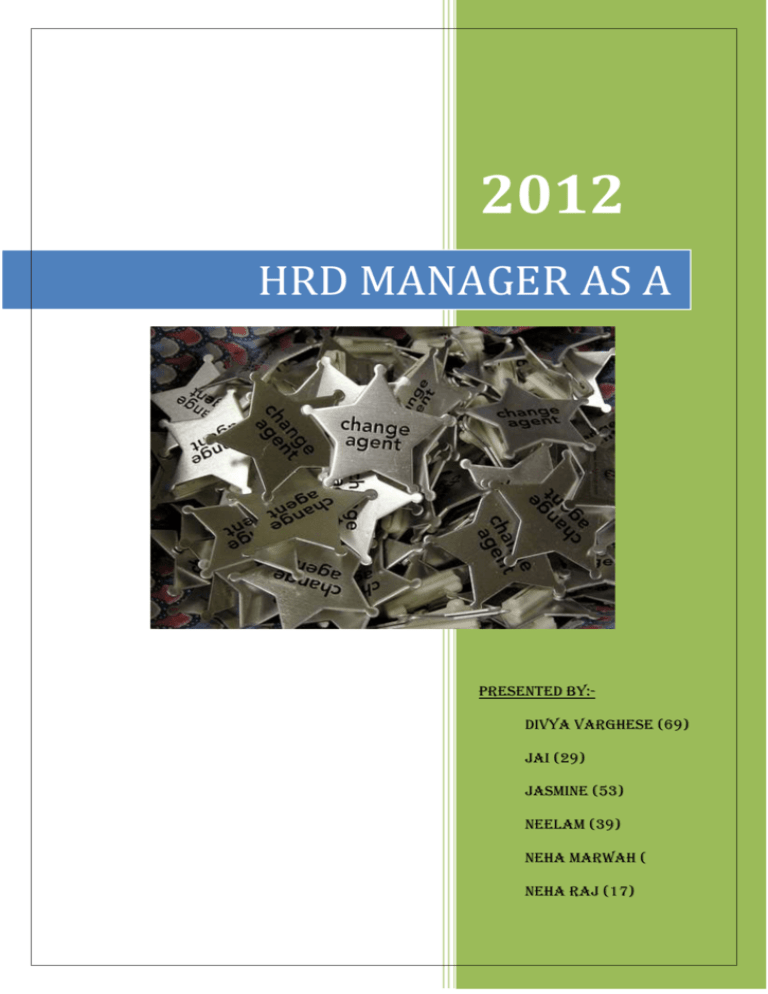
2012 HRD MANAGER AS A Presented by:DIVYA VARGHESE (69) JAI (29) JASMINE (53) NEELAM (39) NEHA MARWAH ( NEHA RAJ (17) Introduction Change management is a structured approach to shifting/transitioning individuals, teams, and organizations from a current state to a desired future state. It is an organizational process aimed at helping employees to accept and embrace changes in their current business environment. In project management, change management refers to a project management process where changes to a project are formally introduced and approved. Kotter defines change management as the utilization of basic structures and tools to control any organizational change effort. Change management's goals is to minimize the change impacts on workers and avoid distractions. Traditionally managers have been asked to select , develop,appraise & reward employees for their performance, but the challenge facing today’s organizations requires them to understand and manage change.Therefore they need to develop area of expertise that are useful during the change process. Person who act as catalysts & assume the responsibility for managing change are called as Change Agents. Change can be brought about by managers,non-managers, employees or an outside consultant. The primary goal of change agent is to help organization improve its effectiveness,performance,renewal capacity & competitive readiness. Usually, change occurs because a problem exists in a process, and there is a clear idea for a better way to do it. While this sounds fairly easy, it often can be quite complicated and frustrating. Without a change control process in place, people will assume that any change is a good change- until it isn't- and that's when it becomes a problem, sometimes an expensive one, for companies. Why Change Management? Don't many organizations simply allow the various department heads to run their territory and then deal with issues that arise afterwards? Yes, many do, but the ones who actively manage the change process say that extra effort pays off. Consider: Any organization that first stops implementation- until approval by a change management group- of any activity or purchase that affects productivity, system security, safety or budgets uses their hindsight far less because they exercised their foresight. Change will inevitably happen. However, in order to benefit from change we need to know how to manage it effectively, so perhaps we need to review some of the key points that will help us accomplish our goals. On the flip side, when we actually have decided upon a change, we will encounter resistance. People in every organization protect the status quo, and will often resist any changes, no matter how slight they may be. Some folks are afraid of change in and of itself, while others are afraid of losing their control over a system or method- and some find no profit from changing a system that they see as working adequately. In addition, some are threatened by automation in change, as a threat to their very livelihood, and will "silently sabotage" any efforts at improvement. This can be everything from playing dumb (can't learn it- it's too complicated) to actual overt and purposeful damage to a new system's data or hardware. Change management uniquely addresses human aspects such as fear, hesitation, and resistance in the process of building and using technology. This alone can create a paradox in making the process both challenging yet fascinating in its orchestration. There are a great many things for us all to consider when it comes to implementing successful and lasting change. Types of Change The external environment like(competitive , regulatory and so on) will continue to play a role in an organizations ability to deliver goods and services, the internal environment within the organization will increasingly inhibit it from delivering products required to meet the demands of the market place unless it is able to adapt quickly. There are numerous roles which HRD practitioner plays these can be categorized as: 1) Strategic: Sometimes in the course of normal business operation it is necessary for management to adjust the firms strategy to achieve the goals of the company or even to change the mission statement of the organization in response to demands of the external environments. Adjusting a company’s strategy may involve changing its fundamental approach to doing business: the markets it will target, the kind of products it will sale, how they will be sold, its overall strategic orientation, the level of global activity, and its various partnership and other joint business arrangements. 2) Structural: Organizations often find it necessary to redesign the structure of the company due to influences from the external environment structural changes involve the hierarchy of authority, goals, structural characteristics, administrative procedures and management systems almost all the changes in how an organization is managed falls under the category of structural change. A structural change may be as simple as implementing a no smoking policy, or as involved as restructuring the company to meet the customers need more effectively. 3) Process Oriented: Organization may need to reengineer to process to achieve optimum work flow and productivity. Process oriented change is often related to an organization production or how the organization assembles product or deliver services. 4) People centered: This type of change alters the attitudes, behavior’s, skills or performance of employees in the company changing people centered process involves communicating, motivating, leading, interacting with in groups. This focus may entail changing how problems are solved, the way employees learned new skills and even the very nature of how employees perceived themselves, their jobs and the organization. Many employees believe that a change is often reactive and nothing more than a quick fix, then they brace themselves for more changes in the future. Management needs to realize that serious underline problems in organization must be addressed with long term consequences in mind. When management implements changes, careful thought must be given to ensure that the new process are for the long term good of the company. Mechanism of Change Management According to Axelrod, there are four approaches to change management: Leader-driven Approach- In this approach change is more suitable for small and medium enterprises with owner-managers. This approach works well when the manager or leader has all the necessary information and knowledge. Leader-driven changes tend to be directive and non-participative. Therefore this approach is less suitable when: a) the workforce is young and/or highly skilled, b) the business environment is complex and dynamic, and c) successful change requires active involvement of a number of people in the organization. Process-driven Approach- In this approach changes are led by experts or outside consultants and supported by the leader; these changes are more common in large, bureaucratic organizations. This approach works well when the change requires technical or specialized expertise Team-driven approach- are most common in large, manufacturing enterprises that have skilled and educated employees. Change management strategies—such as TQM, Quality Circles, and Six Sigma—exemplify this approach. These are highly participative change efforts that empower employees and provide them with involvement, participation and ownership of change. Team-based approaches that are properly executed can unleash enormous levels of employee energy and motivation. This can, in turn, lead to innovation and productivity gains. However, using this approach can also cause some discomfort for managers in an organization because they may not be used to sharing their power and authority with workers. Moreover, this approach requires managers to shift from a directive, authoritarian style based on power and expertise to a participative style based on persuasion, coaching and helping. More importantly, the team-based approach to execute change requires the establishment of a ‘parallel organization.’ Change Management approach- The fourth approach to change is called the Change Management approach. This is a combination of expert-driven and team-driven approaches. Whereas the former provides a business and technical focus to change, the latter generates ownership, involvement and commitment. So as to gain this commitment, most specialists, experts and change management consultants have incorporated the parallel organization concept in their process-driven approach. Change Management Principles Sponsorship Support structures Engagement Planning Measurement Change management principles 1. At all times involve and agree support from people within system (system = environment, processes, culture, relationships, behaviours, etc., whether personal or organisational). 2. Understand where you/the organisation is at the moment. 3. Understand where you want to be, when, why, and what the measures will be for having got there. 4. Plan development towards above No.3 in appropriate achievable measurable stages. 5. Communicate, involve, enable and facilitate involvement from people, as early and openly and as fully as is possible. Various Roles performed by Change Agent ROLE DEFINITION WHEN APPROPRIATE ADVOCATE Highly directive role in which the change agent tries to influence the client to use a certain approach When the client is not sure of the approach to take and needs a lot of direction TECHNICAL SPECIALIST Provides specific technical knowledge on special problems When client seeks direction on a special problem TRAINER Provides information about OD or different intervention strategies When client needs training in some aspects of od FACT FINDER Serves as a research or data collector When clients needs are very specific PROCESS SPECIALIST Facilitates meetings and group processes When client’s needs are for process consultation REFLECTOR Helps client to understand situation by reacting to information When client is not sure of the data and seeks clarification Role of Change Agent in Organizational Development Change agents are the persons who initiate change and manage change in the organizations. They are specialized in theory and practice of managing changes. Change agents have five set of powers as support of managers is essential but not enough. Following are the powers:1. High status given by the members of the client organization, based on their perception that the change agent is similar to them in behaviour, language etc. 2. Trust based on his consistent handling of information and maintaining proper role in the organization. 3. Expertise in the practice of organizational change. 4. Credibility based on experience with previous clients. 5. Dissatisfied constitutions who see the change agents as the best opportunity to change the organization to meet their needs. There are four subject matters which a an HRD manager as a change agent can change. They are as follows: Structure: Structure is defined as how the tasks are formally divided, grouped and co-ordinated. For instance, change in plant layout or new technique can only succeed when the structure is changed according to change in environment. He may also change responsibility, authority, functions, performance according to the need of the change. He might also redesign jobs or work schedule. Technology: The introduction of new equipment and work process is technological change. Automation or computerization is the common technological change. Major technological changes involve introduction of new tools and equipment, automation, computerization. People: This involves changing attitudes and behaviour of members thorugh communication, decision making and problem solving. They help individuals to work more efficiently and effectively together. The changes may only be possible in case the members are positive. In case there is lack of agreement, stress and tension occurs with the employees. Physical Setting: It involves change in interior design, equipment placement, plant layout, tool placement. These changes are helpful in organizational development. Physical setting considers flow process, information flow and outcome. The smoothness of flow increases the effectiveness of changes. Steps in Planned Change Once managers and an organization commit to planned change, they need to create a logical step-by step approach in order to accomplish the objectives. Planned change requires managers to follow an eight-step process for successful implementation which are mentioned below : 1. Recognize the need for change. Recognition of the need for change may occur at the top management level of the organization. The change may be due to either internal or external forces. 2. Develop the goals of the change. Remember that before any action is taken, it is necessary to determine why the change is necessary. Both problems and opportunities must be evaluated. Then it is important to define the needed changes in terms of products, technology, structure, and culture. 3. Select a change agent. The change agent is the person who takes leadership responsibility to implement planned change. The change agent must be alert to things that need revamping, open to good ideas, and supportive of the implementation of those ideas into actual practice. 4. Diagnose the current climate. In this step, the change agent sets about gathering data about the climate of the organization in order to help employees prepare for change. Preparing people for change requires direct and forceful feedback about the negatives of the present situation, as compared to the desired future state, and sensitizing people to the forces of change that exist in their environment. 5. Select an implementation method. This step requires a decision on the best way to bring about the change. Managers can make themselves more sensitive to pressures for change by using networks of people and organizations with different perspectives and views, visiting other organizations exposed to new ideas, and using external standards of performance, such as competitor's progress. 6. Develop a plan. This step involves actually putting together the plan, or the “what” information. This phase also determines the when, where, and how of the plan. The plan is like a road map. It notes specific events and activities that must be timed and integrated to produce the change. It also delegates responsibility for each of the goals and objectives. 7. Implement the plan. After all the questions have been answered, the plan is put into operation. Managers can maintain the momentum for change by providing resources, developing new competencies and skills, reinforcing new behaviours, and building a support system for those initiating the change. 8. Follow the plan and evaluate it. During this step, managers must compare the actual results to the goals established. It is important to determine whether the goals were met; a complete follow-up and evaluation of the results aids this determination. Change should produce positive results and not be undertaken for its own sake. A comprehensive model of planned change includes a set of activities that managers must engage in to manage the change process effectively. They must recognize the need for change, motivate change, create a vision, develop political support, manage the transition, and sustain momentum during the change. Some of these pitfalls while implementing changes are as follows: Faulty thinking Inadequate change process Insufficient resources Lack of commitment to change Poor timing A culture resistant to change Opposition to Organizational Changes A manager designs his or her change effort, and then faces the toughest step: the inevitable opposition. History shows that workers have resisted some of the best-laid plans. A few may openly fight it. Many more may ignore or try to sabotage a manager's plan. Here are some of the most common reasons employees resist change: Uncertainty and insecurity Reaction against the way change is presented Threats to vested interests Cynicism and lack of trust Perceptual differences and lack of understanding To overcome resistance, managers can involve workers in the change process by communicating openly about changes, providing advance notice of an upcoming change, exercising sensitivity to workers' concerns, and reassuring workers that change will not affect their security. Kurt Lewin’s Change Management Model The Kurt Lewin change theory model is based around a 3-step process (UnfreezeChange-Freeze) that provides a high-level approach to change. It gives a manager or other change agent a framework to implement a change effort, which is always very sensitive and must be made as seamless as possible. The Kurt Lewin model can help a leader do the following three steps: Unfreezing Transition Refreezing This three step model gives a manager or change agent an idea of what implementing change means when dealing with people. The 3 phases of the Kurt Lewin model provide guidance on how to go about getting people to change: a manager will implement new processes and re-assign tasks, but change will only be effective if the people involved embrace it and help putting it into practice it. Unfreezing A basic tendency of people is to seek a context in which they have relative safety and feel a sense of control. In establishing themselves, they attach their sense of identity to their environment. This creates a comfortable stasis from which any alternatives, even those which may offer significant benefit, will cause discomfort. Talking about the future thus is seldom enough to move them from this 'frozen' state and significant effort may be required to 'unfreeze' them and get them moving. This usually requires Push methods to get them moving, after which Pull methods can be used to keep them going. The term 'change ready' is often used to describe people who are unfrozen and ready to take the next step. Some people come ready for change whilst others take a long time to let go of their comfortable current realities. Transition A key part of Lewin's model is the notion that change, even at the psychological level, is a journey rather than a simple step. This journey may not be that simple and the person may need to go through several stages of misunderstanding before they get to the other side. A classic trap in change is for the leaders to spend months on their own personal journeys and then expect everyone else to cross the chasm in a single bound. Transitioning thus requires time. Leadership is often important and when whole organizations change, the one-eyed person may be king. Some form of coaching, counseling or other psychological support will often be very helpful also. Refreezing At the other end of the journey, the final goal is to 'refreeze', putting down roots again and establishing the new place of stability. In practice, refreezing may be a slow process as transitions seldom stop cleanly, but go more in fits and starts with a long tail of bits and pieces. There are good and bad things about this. In modern organizations, this stage is often rather tentative as the next change may well be around the next corner. What is often encouraged, then, is more of a state of 'slushiness' where freezing is never really achieved (theoretically making the next unfreezing easier). The danger with this that many organizations have found is that people fall into a state of change shock, where they work at a low level of efficiency and effectiveness as they await the next change. 'It's not worth it' is a common phrase when asked to improve what they do. Kotter’s 8 Steps to Successful Change John Kotter (who teaches Leadership at Harvard Business School) has made it his business to study both success and failure in change initiatives in business. "The most general lesson to be learned from the more successful cases is that the change process goes through a series of phases that, in total, usually require a considerable length of time. Skipping steps creates only the illusion of speed and never produces satisfactory results" and "making critical mistakes in any of the phases can have a devastating impact, slowing momentum and negating hard-won gains". Kotter summarizes the eight phases as follows: 1. Establish a Sense of Urgency Talk of change typically begins with some people noticing vulnerability in the organization. The threat of losing ground in some way sparks these people into action, and they in turn try to communicate that sense of urgency to others. In congregations it is typically membership loss, financial struggles or turnover in key volunteers and leaders. Kotter notes that over half the companies he has observed have never been able to create enough urgency to prompt action. "Without motivation, people won’t help and the effort goes nowhere…. Executives underestimate how hard it can be to drive people out of their comfort zones". In the more successful cases the leadership group facilitates a frank discussion of potentially unpleasant facts: about the new competition, flat earnings, decreasing market share, or other relevant indicators. It is helpful to use outsiders (consultants) who can share the "big picture" from a different perspective and help broaden the awareness of your people. 2. Form a Powerful Guiding Coalition Change efforts often start with just one or two people, and should grow continually to include more and more who believe the changes are necessary. The need in this phase is to gather a large enough initial core of believers. This initial group should be pretty powerful in terms of the roles they hold, the reputations they have, the skills they bring and the relationships they have. Regardless of size of your organization, the "guiding coalition" for change needs to have 3-5 people leading the effort. This group, in turn, helps bring others on board with the new ideas. The building of this coalition – their sense of urgency, their sense of what’s happening and what’s needed – is crucial. Involving respected leaders from key areas in this coalition will pay great dividends later. 3. Create a Vision Successful transformation rests on "a picture of the future that is relatively easy to communicate and appeals to customers, stockholders, and employees. A vision helps clarify the direction in which an organization needs to move". The vision functions in many different ways: it helps spark motivation, it helps keep all the projects and changes aligned, it provides a filter to evaluate how the organization is doing, and it provides a rationale for the changes the organization will have to weather. "A useful rule of thumb: if you can’t communicate the vision to someone in five minutes or less and get a reaction that signifies both understanding and interest, you are not yet done with this phase of the transformation process". 4. Communicate that Vision Kotter suggests the leadership should estimate how much communication of the vision is needed, and then multiply that effort by a factor of ten. Do not limit it to one congregational meeting, a couple of emails. Leaders must be seen "walking the talk" – another form of communication -- if people are going to perceive the effort as important. "Deeds" along with "words" are powerful communicators of the new ways. The bottom line is that a transformation effort will fail unless most of the people understand, appreciate, commit and try to make the effort happen. The guiding principle is simple: use every existing communication channel and opportunity. 5. Empower Others to Act on the Vision This entails several different actions. Allow people in the church to start living out the new ways and to make changes in their areas of involvement. Allocate budget money to the new initiative. Carve out time on the agenda to talk about it. Change the way your organization is organized to put people where the effort needs to be. Free up key people from existing responsibilities so they can concentrate on the new effort. In short, remove any obstacles there may be to getting on with the change. Nothing is more frustrating than believing in the change but then not having the time, money, or support needed to effect it. You can’t get rid of all the obstacles, but the biggest ones need to be dealt with. 6. Plan for and Create Short-Term Wins Since real transformation takes time, the loss of momentum and the onset of disappointment are real factors. Most people won’t go on a long march for change unless they begin to see compelling evidence that their efforts are bearing fruit. In successful transformation, leaders actively plan and achieve some short-term gains which people will be able to see and celebrate. This provides proof that their efforts are working, and adds to the motivation to keep the effort going. "When it becomes clear to people that major change will take a long time, urgency levels can drop. Commitments to produce short-term wins help keep the urgency level up and force detailed analytical thinking that can clarify or revise visions". 7. Consolidate Improvements and Keep the Momentum for Change Moving As Kotter warns, "Do not declare victory too soon". Until changes sink deeply into an organization’s culture -- a process that can take time-- new approaches are fragile and subject to regression. Again, a premature declaration of victory kills momentum, allowing the powerful forces of tradition to regain ground. Leaders of successful efforts use the feeling of victory as the motivation to delve more deeply into their organization: to explore changes in the basic culture, to expose the systems relationships of the organization which need tuning, to move people committed to the new ways into key roles. Leaders of change must go into the process knowing that their efforts will a while. 8. Institutionalize the New Approaches In the final analysis, change sticks when it becomes "the way we do things around here", when it seeps into the bloodstream of the corporate body. "Until new behaviors are rooted in social norms and shared values, they are subject to degradations as soon as the pressure for change is removed". Two factors are particularly important for doing this. First, a conscious attempt to show people how the new approaches, behaviors, and attitudes have helped improve the life of the organization. People have to be helped to make the connections between the effort and the outcome. The second is to ensure that the upcoming leaders believe in and embody the new ways. Conclusion The business environment today is ever changing in terms of technologies, market & industry. Any change from a set pattern evokes fear about the uncertainty that lies ahead. Thus transformation has to be dealt with carefully & converted into an opportunity. The basic principle has to be understood by HR managers & through them by all the employees and only then the desired change can be brought. HR managers have to take up this challenge if they have to grow & develop into becoming business partners within the organizations. They need to take the lead in managing change. This involves guiding leading, enabling & motivating people. HR has to play a major role in formulating & implementing change, as it adds value to the most important resource i.e. the human resource. Bibliography HBR Article: "Leading Change: Why Transformation Efforts Fail" by John Kotter. Harvard Business Review, March-April 1995. Book: "Leading Change" by John Kotter. Harvard Business School Press, 1996. http://siriusmeetings.com/files/8steps1.pdf http://changingminds.org/disciplines/change_management/lewin_change/lewin_change.htm http://www.google.co.in/ http://www.businessballs.com/changemanagement.htm http://www.citehr.com/287394-role-change-agent-organization-development-change.html

